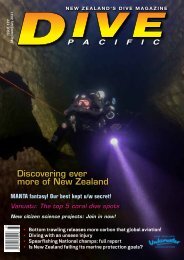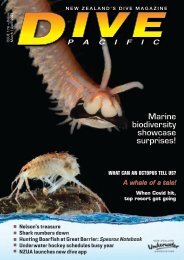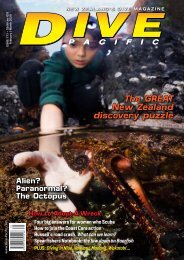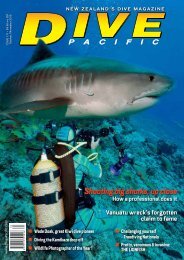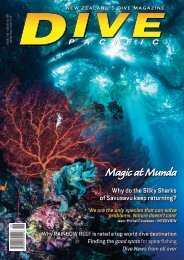Dive Pacific 175 Dec2020 Jan 2021
Dive Pacific, New Zealand's Dive Magazine , captures the best of diving in New Zealand and the Pacific. with adventures, top photos and expert technical advice
Dive Pacific, New Zealand's Dive Magazine , captures the best of diving in New Zealand and the Pacific. with adventures, top photos and expert technical advice
Create successful ePaper yourself
Turn your PDF publications into a flip-book with our unique Google optimized e-Paper software.
Kermadec Islands<br />
number of herbivorous fishes,<br />
including drummers, marblefish and<br />
Parma anglefishes. Here they are more<br />
diverse in their diet, relying more on<br />
plankton, and it is not uncommon to<br />
see large schools of drummer feeding<br />
on salps in the top couple of metres of<br />
the water column.<br />
The mobile invertebrates are chiefly<br />
tropical: crown-of-thorns starfish,<br />
tropical urchins, exquisite crustaceans<br />
and gastropods. Perhaps the most<br />
iconic are the giant limpets, endemic<br />
to the islands, and dominating the<br />
shallow surge zone.<br />
Splendid hawkfish (Notocirrhitus splendens)<br />
…Gratitude for wild places like<br />
this, left for nature, without<br />
human interference…<br />
However due to its isolation, and<br />
compared with other places, the<br />
knowledge of this underwater world<br />
is relatively low. Even from our few<br />
days there, between us we recorded at<br />
least two fish species that we hadn’t<br />
encountered in New Zealand before.<br />
Predators<br />
Two large predators patrol the reefs.<br />
The Galapagos sharks are very<br />
common, a great sign of a healthy<br />
ecosystem, and they are our near-constant,<br />
yet distant, companions on<br />
dives. As dusk approaches each day,<br />
we find their curiosity increasing.<br />
Several close encounters ensue!<br />
Fortunately, most are less than a<br />
couple of metres, and as I consider<br />
there to be a basic size hierarchy with<br />
sharks, so as long as I am longer than<br />
them, I’m happy!<br />
Hingebeak shrimp & diadema urchin<br />
Grey moray (Gymnothorax nubilus) in soft coral<br />
The other large fish predator we<br />
encounter is the charismatic spotted<br />
black grouper. The Kermadecs are the<br />
last bastion of healthy populations<br />
of this species which reach nearly<br />
two metres long! Being long lived and<br />
easy to catch, they are vulnerable to<br />
overfishing, irrespective of the marine<br />
reserve status, and they are fully<br />
protected throughout New Zealand,<br />
in fact one of only two species of bony<br />
fish in New Zealand that are. But, here<br />
there is megafauna even larger than<br />
either sharks or the grouper.<br />
www.dive-pacific.com 37




